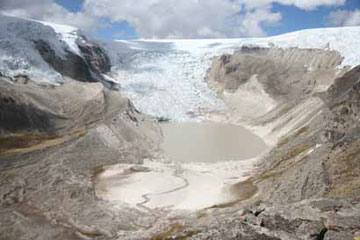Largest tropical glacier retreating at 200 feet per year in Peru
Largest tropical glacier retreating at 200 feet per year in Peru
mongabay.com
February 19, 2007
Peru’s largest glacier is melting rapidly and could complete disappear by 2012 says a glaciologist from Ohio State University.
Speaking at the annual meeting of the American Association for the Advancement of Science in San Francisco last week, Dr. Lonnie Thompson said that Peru’s Qori Kalis glacier is melting at a rate of some 60 meters (200 feet) per year. Qori Kalis glacier is part of the Quelccaya Ice Cap, the largest body of ice in the tropics
Thompson, who has visited the Quelccaya ice cap at least 27 times since 1974, said the melting provides strong evidence of global warming. He notes that tropical glaciers around the world are in retreat.
“Kilimanjaro is behaving just like Mount Kenya and the Rwenzori, both also in Africa, as well as the glaciers in the Andes and the Himalayas ,” he said. “This widespread retreat of mountain glaciers may be our clearest evidence of global warming as they integrate many climate variables. Most importantly, they have no political agenda.”
 The Qori Kalis Glacier, image courtesy of Lonnie Thompson. |
Thompson said the loss of glaciers has implications for local populations that rely on these ice caps for regular water supplies.
“These glaciers are going to be gone,” he says. “If you a living at the base of one of these mountains, it doesn’t matter why they’re disappearing — only that they are. Millions of people are going to have to adapt to these changes, many of which will occur in some of the poorest regions of the globe.”
The Peruvian government estimates that the country’s glaciers have shrunk by more than 20% in the past 30 years. The disappearance of glaciers, which are the source for as much as 50 percent of the water in the upper Amazon, could have a significant impact on the rainforest ecosystem of the Amazon.
Related articles
The Amazon River in Peru and parts of Brazil is at its lowest level in 30 years of record keeping. While variable water levels are characteristic of the Amazon river ecosystem, the increasingly extreme fluctuations are of great concern. Low water levels are wreaking havoc on the shipping industry in the region. In Iquitos, a city in the heart of the Peruvian Amazon which is only accessible by plane or boat, ships and barges are having difficulty navigating the river, resulting in serious shipping delays. Local officials in Peru are blaming deforestation of the upper reaches of the Amazon in the Andes for the fall in river levels, although it is likely that larger forces are at least equally important.
Last 50 years ‘unusually warm’, tropical glaciers melting rapidly finds research. Researchers studying ancient tropical ice cores have found evidence of two abrupt climate shifts — one 5000 years ago and one currently underway. The findings, published in the current issue of the journal Proceedings of the National Academy of Science, may have important implications for immediate future since more than two-thirds of the world’s population resides in the tropics.
Africa’s glaciers gone by 2025. Fabled equatorial icecaps will disappear within two decades, because of global warming, a study British and Ugandan scientists has found. In a paper to be published 17 May in Geophysical Research Letters, they report results from the first survey in a decade of glaciers in the Rwenzori Mountains of East Africa. An increase in air temperature over the last four decades has contributed to a substantial reduction in glacial cover, they say.
Global warming shrinks sacred glacier in the Andes. The melting of a glacier in the Peruvian Andes due to global climate change is impacting the religious practices of local people, according to an article run last month in The Wall Street Journal.
Global warming will reduce glaciers, water supply and affect millions of people. In the looming future, global warming will reduce glaciers and storage packs of snow in regions around the world, causing water shortages and other problems that will impact millions of people. That is the conclusion of researchers at Scripps Institution of Oceanography at the University of California , San Diego, and the University of Washington in a review paper published in the November 17 issue of the journal Nature.
This article is based on a news release from Ohio State University.